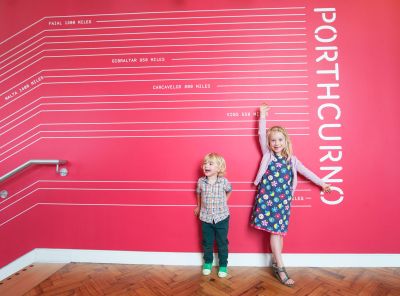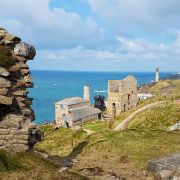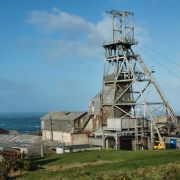
Sir John Pender formed the Falmouth-Gibraltar-Malta Telegraph Company in 1876. He had been associated with the Atlantic cable of 1866 and now hoped to form a link with a submarine route to India.
The inland system from London to Falmouth was operated by the nationalised Post Office, which was why Falmouth was initially chosen as the terminal for the new cable. However Falmouth was a busy shipping harbour and the cable would have been in jeopardy from dragging anchors. Consequently the inland system was extended to Porthcurno and the name of the Company was eventually changed to the Eastern Telegraph Company.
Porthcurno, known as PK in telegraphic abbreviation, was to prove an ideal site for a cable landing, with its sandy beach protected from by the adjacent headland. On June 8th 1870 John Pender sat in a hut above the beach and watched the first message transmitted.
As a major cable station, Porthcurno was an obvious enemy target during the First World War. In 1914, a detachment of soldiers arrived to sandbag windows, erect barbed wire and dig trenches on the beach. A censor was posted and a wireless hut on the cricket field was commandeered by the Senior Inspector of Telegraphs. During the Second World War, tunnels were cut into the cliffs by local tin miners and the communications operations were moved inside. Flame throwers were also set up on the beach. The underground tunnel took ten months to complete. It was fully equipped with a power plant and blast-proof doors. In addition, there was an escape route to the hilltop above. The camouflaged tunnels were guarded and designed to prevent invasion but no bombs were dropped directly onto Porthcurno, so the escape route was never needed.
Among various displays in the museum is a colour film from 1941 showing the flamethrowers being tested. The museum also hosts a local history research centre investigating the history of the parish of St Levan. A large collection of old photographs, documents and other artefacts are on permanent display.
Porthcurno is situated just three miles away from Land’s End, and close to St Buryan village. Buses run from Penzance bus station. The main car park is at the bottom of the hill and there is a charge from Easter to September. The museum is open daily from Easter until the end of October and at various other times throughout the winter. It is best to check the times of opening before visiting out of season.
Guide dogs are welcome in the museum but other dogs are not allowed during July and August. There is parking for disabled drivers and passengers close to the museum and an area right outside the museum entrance where disabled passengers can be dropped off. The inside of the museum is accessible for wheelchair users. The museum shop sells drinks and snacks.








